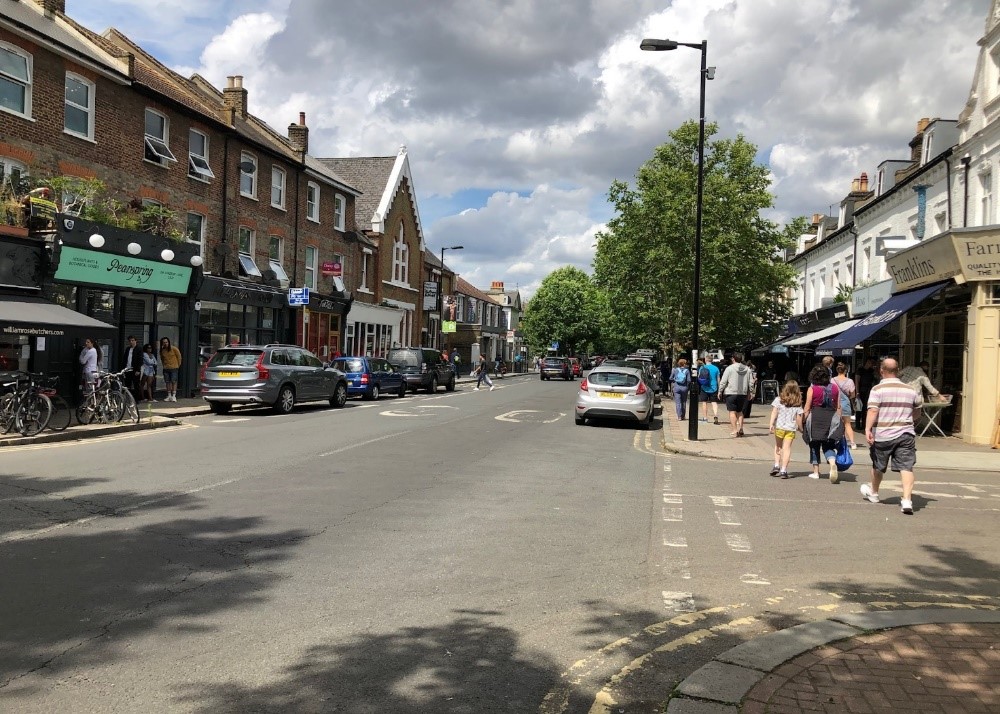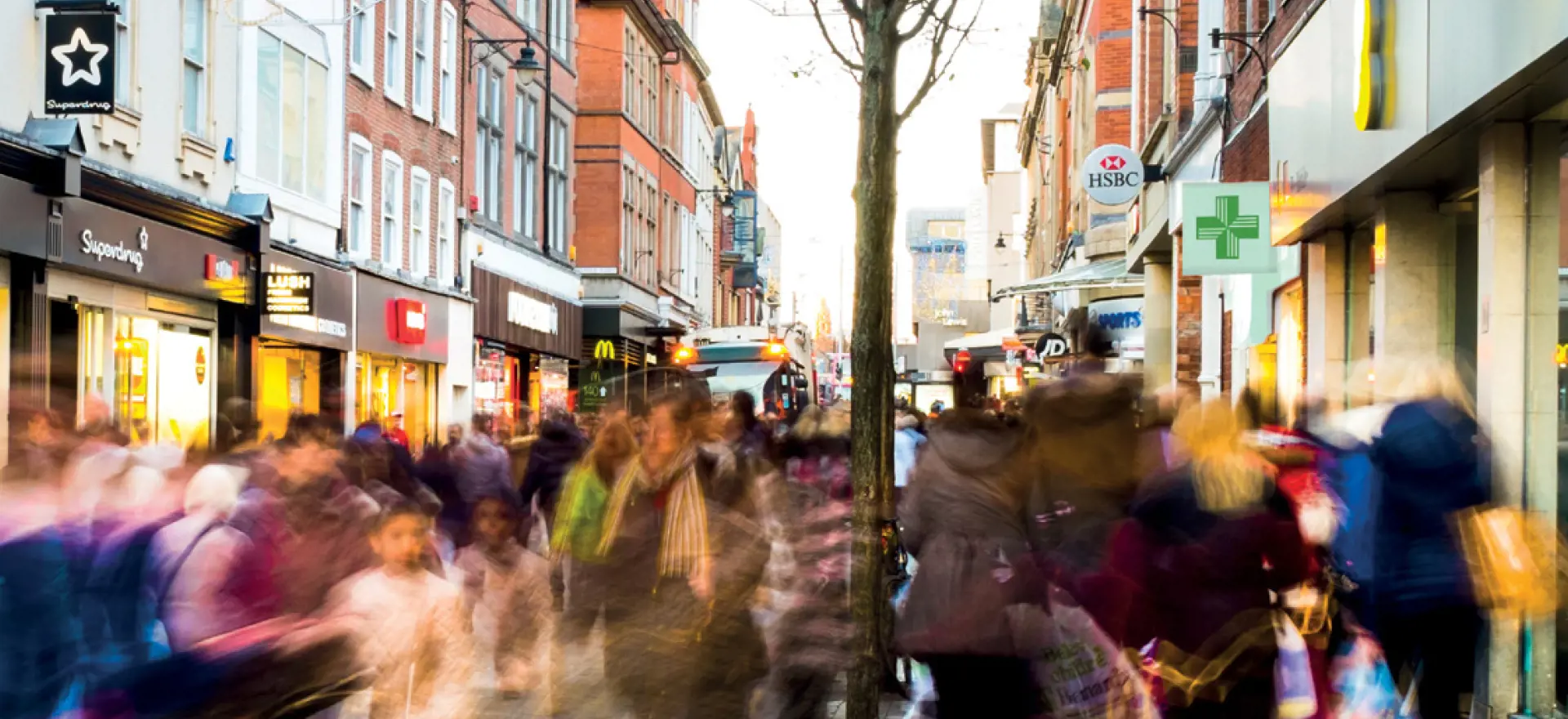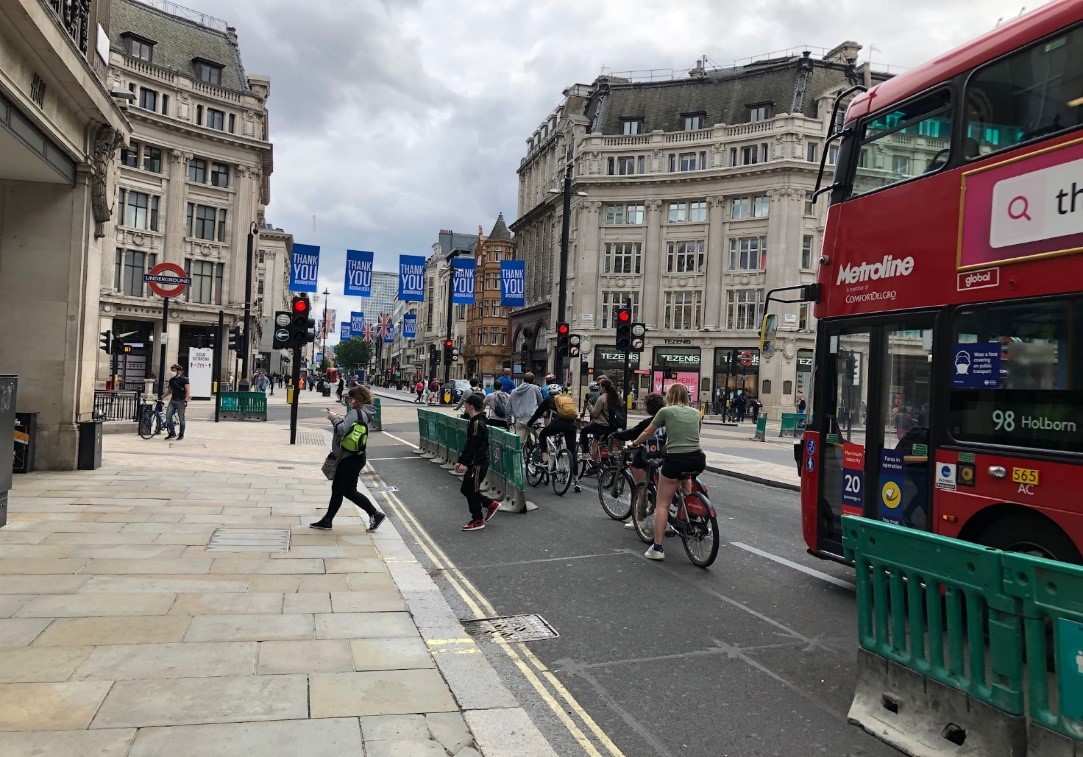On Friday, the latest ONS retail figures
[1] showed High Streets had started to bounce back. There had been a 12% increase in retail spend in May 2020 compared to April's record 18% drop
[2], primarily driven by growth in food, DIY and garden centre goods and non-store retailing. It’s nonetheless 14% lower than in May 2019, the average hiding a wide range of variations across the different retail sectors.
Since then, and from 15 June, ‘non- essential’ shops have been re-opening, so the statistics will no doubt be improving. High Streets Task Force (HSTF) footfall data for Monday 15 June showed this to be an average of 65% of that experienced on the same Monday last year, excluding London where footfall across the capital was much lower
[3].
But how does this feel on the ground and what are the signs of how high streets might transform after the COVID-19 pandemic?
Shopping in London

Lordship Lane, East Dulwich, SE22
In south London, I anecdotally observed that Walworth Road / Elephant & Castle (a ‘Major Centre’ in London’s ‘Town Centre Network’), East Dulwich (a ‘District Centre’) and other nearby district and local centres all had increased footfall last week, but by far the greatest shopping activity remained at the food and drink shops and market stalls – albeit last week’s media reports suggested that this varied across the country too. Lockdown’s eating and drinking at home (and now sharing picnics in gardens and parks with friends and family) is still keeping the supermarkets, independent food shops and markets busy, despite 33% of all retail spend now being online.
Oxford Circus, Oxford Street, London
‘Comparison shopping’ (as it was once known) in London’s West End presents another picture. At 10am on Saturday 20 June, the West End was almost as quiet as in early Lockdown, but by 11 o’clock there was the occasional short queue outside Oxford Street stores (as individual shops reached their number per sq. m quota
[4]). By 1pm, it felt close to a pre-Covid weekday. Everyone in-store seemed accustomed to distancing from shop staff and other customers, following the one-way route markers, and using the separate entry and exits points at larger stores.
Next, Oxford Street, London
The hard part is understanding the rationale for different retailers’ policies – i.e. being able to try on shoes and outerwear at some shops (but not anything requiring a changing room) and not at others. The latter leads to trying on everything purchased at home and having to return the goods to the store within a week or a month if dissatisfied. That makes the experience closer to shopping online (returns are more of a nuisance), but at least one can see and gingerly touch goods, be informed by 1:1 advice before making a selection and have immediate self-delivery.
Small numbers of West End ‘shopper visitors’ seem to be using public transport to get there. Others are driving, but the dominant travel mode is cycling. Once there, those walking the streets are predominantly couples or small groups, demonstrating that shopping remains a sociable activity we want to share.
Transformational Trends
Walking and cycling continue to become more attractive options in many towns. In the capital, Transport for London and boroughs councils are rapidly allocating more road space to accommodate the significant increase in active travel modes
[5]. Some streets are now or will become car-free and others have newly restricted private vehicle use. The Mayor’s Healthy Streets policies
[6] and initiatives are in effect being accelerated to accommodate pandemic-based travel demand which, as a consequence, is helping to maintain enjoyment of the clearer skies and better air quality – at least during the summer.
But will these green shoots of optimism, that vitality and viability will return to our town centres and high streets grow to become the ‘new normal’? Will sociable activities occur in central areas, with social-distancing continuing in a future ‘pandemic cautious’ world?
Town centres have always been the places where people come together to meet to exchange goods, services, money, ideas, leisure and other experiences. They have always continually evolved, as society’s needs and demands of them change. Inevitably, the current pandemic has and continues to rapidly accelerate their C21 evolution.
The transformational trends or latest pressures on our high streets affect demand for space and its use, the design of buildings and public realm, and transport access.
On space and its uses, we are seeing (and will see more of):
- An increasing functional demand to work and shop remotely and more locally, to enjoy community, cultural and leisure activities locally too, all within a continuing decrease in retail space demand overall;
- Greater fusion of uses or sharing spaces across longer days: sports shops with physiotherapy rooms; organic foods and household goods, alongside therapy rooms and yoga studios; and daytime coffee shops transforming in the evening into wine bars or craft beer taps;
- New innovations in high street leisure, continuing the escape rooms, ping pong and crazy golf trend;
- Increasing numbers of new homes being delivered above a wider range of ground / lower floor uses and on the edges of consolidated centres, alongside school, civic, community and other activities
On design:
- Separate entry and exist points being provided at all but the smallest shops, with the redesign of internal retail layouts to accommodate change in a shopper-friendly yet commercial manner;
- New, active frontages including restaurant, bakery and coffee-making windows, accommodating a switch from ‘dark’ to ‘light’ kitchens (as more vacant retail space becomes available);
And on transport:
- Reduced or removed on-street car parking, so as to devote more space to outdoor café seating, shop queuing & window browsing, walking and (covered/ secure) cycle parking, and to better integrate shopping on both sides of a high street;
- Through traffic removal in some but not most centres, with buses remaining but reducing as modal shifts occur (and when autonomous vehicles become a reality);
- Servicing to all types of high street occupiers occurring more outside main trading hours.
The commerciality of centres and opportunities for development will remain, but what works will differ as centres develop more distinctive mixes in response to greater local demand. This points to new challenges to larger and sub-regional centres, but probably not the regional capitals and central London, where their long standing, multi-functional base will provide a more robust platform from which to transform - and assuming that tourism and overnight hospitality reignites in the latter.
Transformational Partnering and Outcomes
Many local planning authorities are grasping the nettle to lead the charge in identifying, masterplanning, curating and delivering required change, working with local communities, private sector partners and other stakeholders operating in their town centres and high streets. Basingstoke, Bishop Auckland, Redcar, Staines and Woolwich are a few examples of town centres where Lichfields is currently working to help shape and deliver change to achieve stronger futures.
Nationally, Government Funds
[7] (£3.6bn for Town Deals, £1bn for Future High Streets and Historic England’s High Streets Heritage Action Zones, and £50m for Reopening High Street Safely) are adding significant resource to deliver positive change in our town centres. The HSTF has been established to provide advice and support on Covid-19 recovery and high street transformation
[8]. The HSTF has been undertaking research, and building resource and skills base capability, prior to launching full services imminently. On 19 June, the HSTF held the first of five ‘Route Map to Transformation’ webinars, sharing and discussing experiences across the country to help others create and deliver changes in their own centres. The ‘Route Map’ comprises a ‘4Rs’ proposition: Restructure, Reposition, Rebrand and Re-invent, with most parties presently grappling with how to restructure and place manage their different centres.
There are clearly strong aspirations, creative curating and development, alongside additional public funding streams and management going into our town centres right now, with a focus on quick delivery this year and next, as well as the longer term. It’s an unchartered journey of seeking to carve out positive change, especially where there have been business and development failures.
The desire to pro-actively plan, collaboratively design and curate a change for the better in our high streets has never been more needed and it does feel that we have the collective resolve to rise to that challenge. How that is manifest will only be evident over time, although observed changes already underway are clear indicators. We will continue to analyse and comment on the changes in future ‘high street’ blogs.
Other blogs in this series:
[1] ONS, June 2020, Retail Sales Index[2] Lichfields 19 June https://twitter.com/LichfieldsTT/status/1273985269314785282[3] High Street Task Force Research – presented by Cathy Parker, HSTF Research Lead, at HSTF webinar 19 June.[4] The Prime Minister’s announcement today of the likely retraction of 2m in favour of 1m social distancing will have a significant impact on the high street, both for the ‘first movers’ adjusting again and for others for whom it might tip the balance to make re-opening profitable.[5] Streetspace for London plan, Transport for London, TfL website[6] The London Plan – Intend to Publish version, December 2019, Policy T2: Healthy Streets[7] MHCLG website: e.g. https://www.gov.uk/government/news/1-billion-future-high-streets-fund-expanded-to-50-more-areas[8] https://www.highstreetstaskforce.org.uk/






